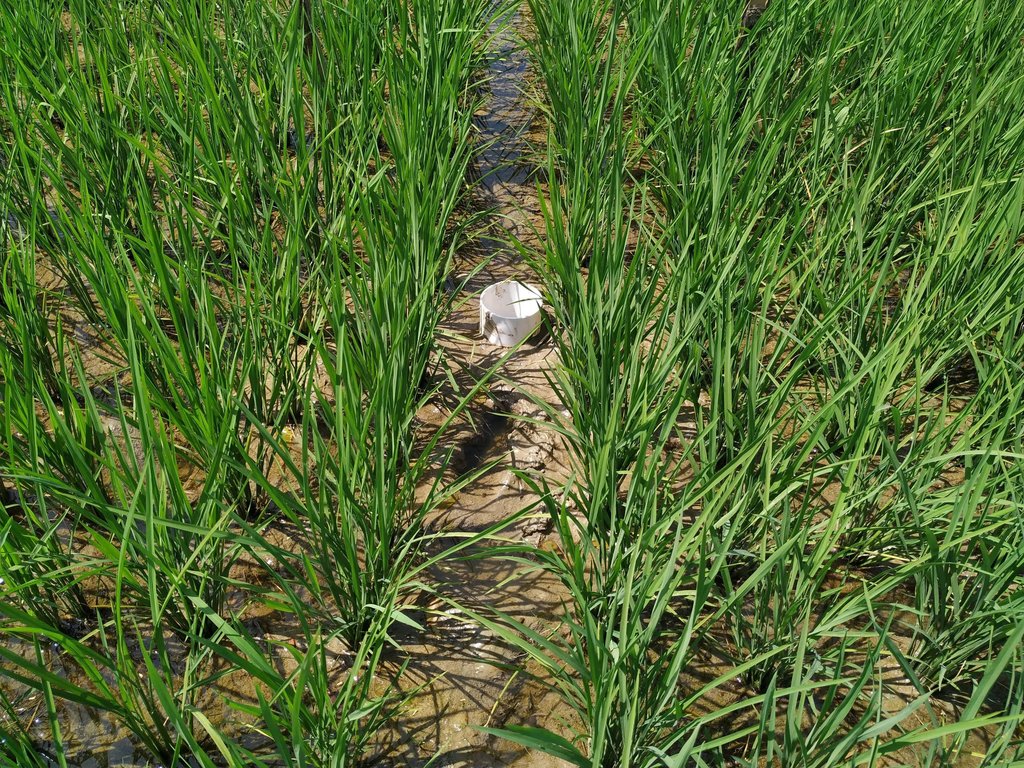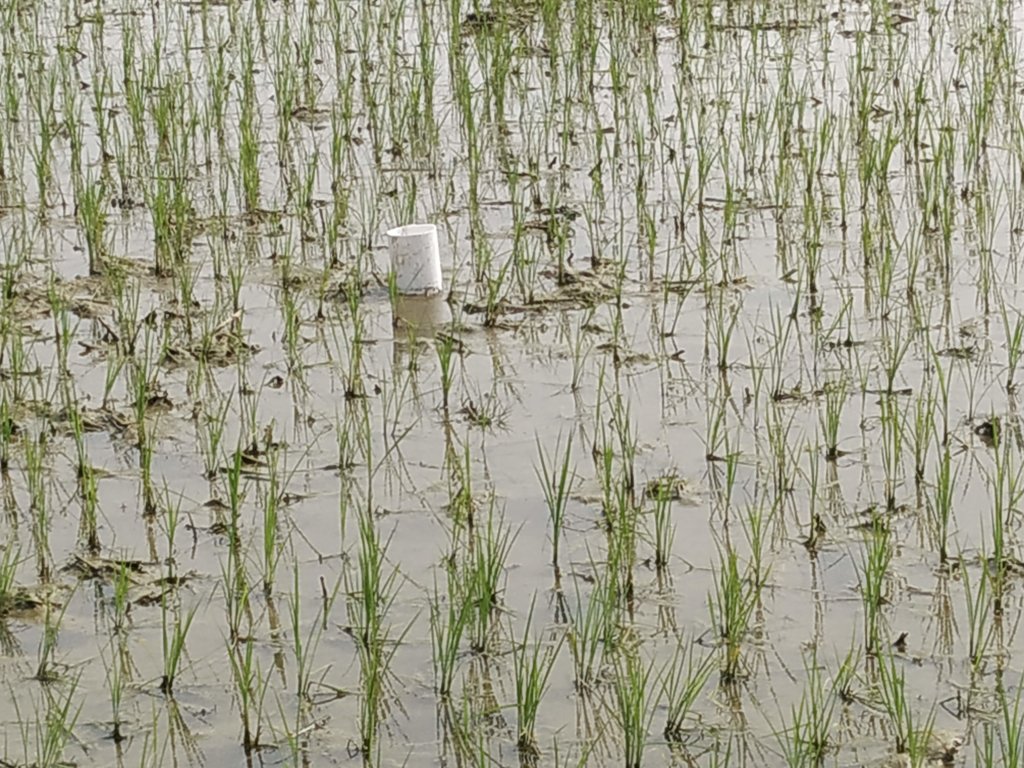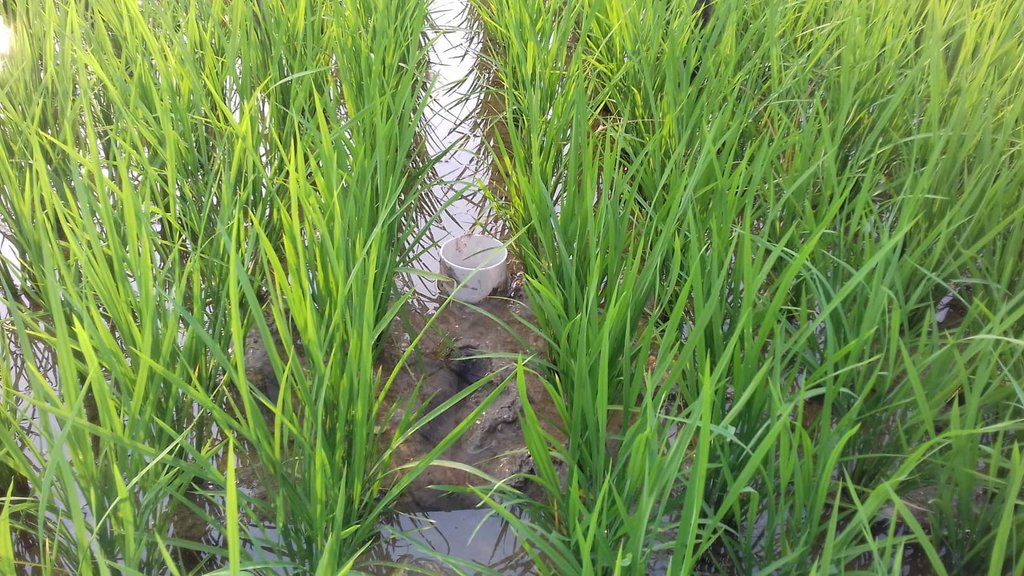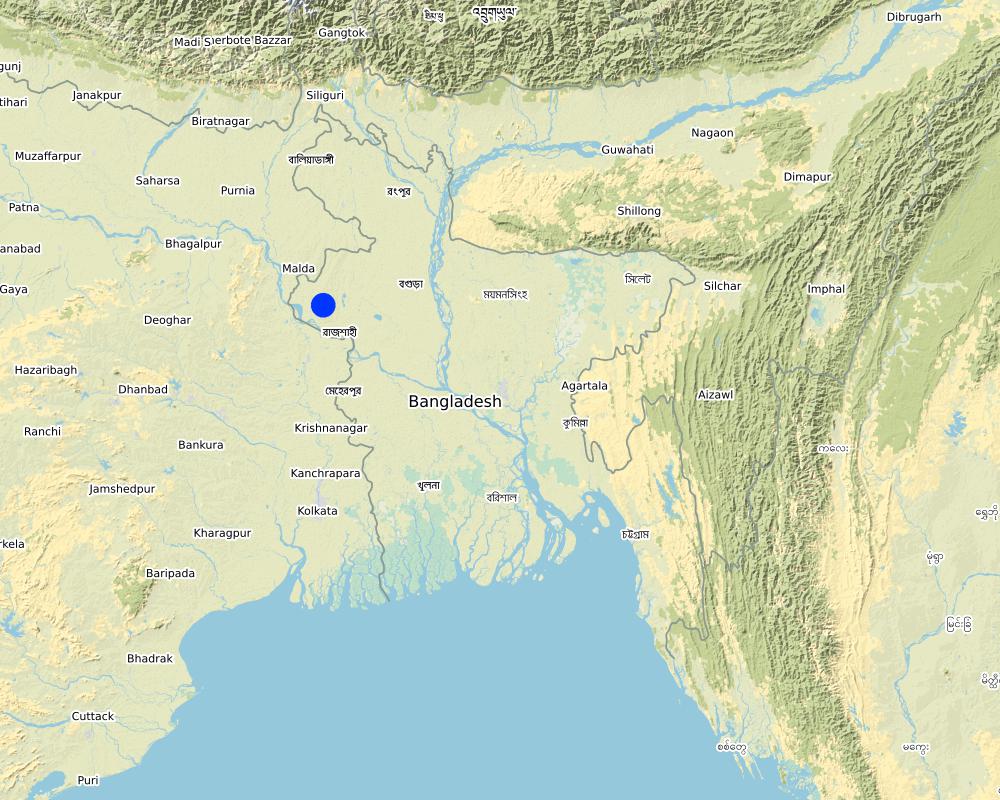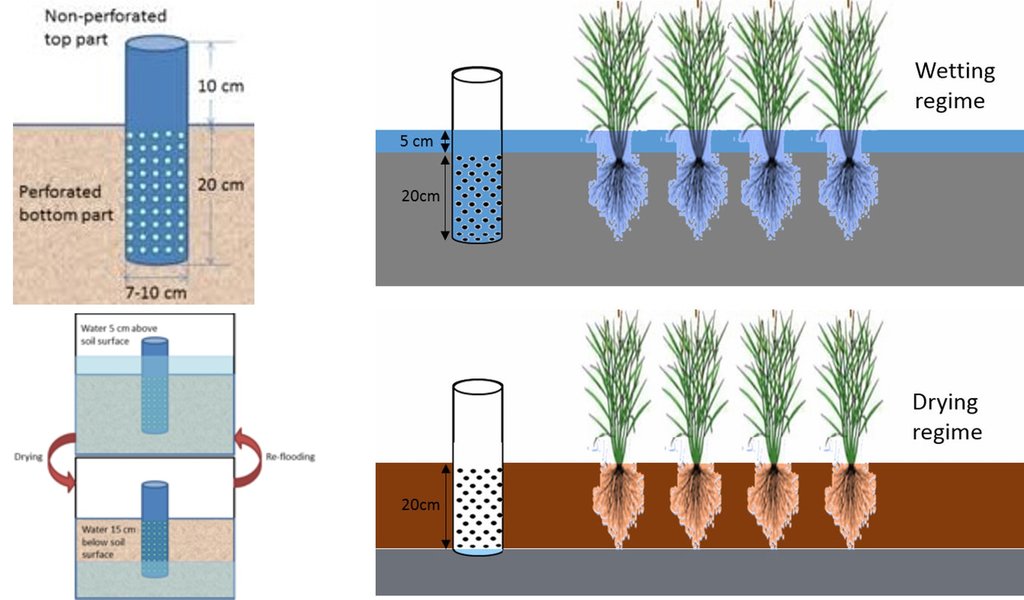Alternate wetting and drying (AWD) method in rice cultivation [孟加拉国]
- 创建:
- 更新:
- 编制者: Mutasim Billah
- 编辑者: Md. Monzurul Haque, Matieu Henry
- 审查者: Nicole Harari, Rima Mekdaschi Studer, Ursula Gaemperli
Magic pipe er madhomme kom panite dhan chas
technologies_4671 - 孟加拉国
查看章节
全部展开 全部收起1. 一般信息
1.2 参与该技术评估和文件编制的资源人员和机构的联系方式
土地使用者:
Zaman Md. Shahid Uz
Farmer
孟加拉国
co-compiler:
Azad Md. Abul Kalam
Department of Agricultural Extension (DAE)
孟加拉国
co-compiler:
Jalal Uddin Dewan
Department of Agricultural Extension (DAE)
孟加拉国
有助于对技术进行记录/评估的项目名称(如相关)
Decision Support for Mainstreaming and Scaling out Sustainable Land Management (GEF-FAO / DS-SLM)有助于对技术进行记录/评估的机构名称(如相关)
FAO Bangladesh (FAO Bangladesh) - 孟加拉国有助于对技术进行记录/评估的机构名称(如相关)
Department of Agricultural Extension (DAE) - 孟加拉国有助于对技术进行记录/评估的机构名称(如相关)
Barind Multipurpose Development Authority (BMDA) - 孟加拉国1.3 关于使用通过WOCAT记录的数据的条件
编制者和关键资源人员接受有关使用通过WOCAT记录数据的条件。:
是
1.4 所述技术的可持续性声明
这里所描述的技术在土地退化方面是否存在问题,导致无法被认为是一种可持续的土地管理技术?:
否
2. SLM技术的说明
2.1 技术简介
技术定义:
Alternative Drying and Wetting (AWD) is a practice in rice cultivation which decrease water use, while having no impact on rice yield. It also decreases the amount of methane into the atmosphere and fuel consumption of water pumps.
2.2 技术的详细说明
说明:
The Rajshahi, Chapai Nawabganj and Naogaon regions of Bangladesh geographically belong to High Barind Tract (HBT) of Bangladesh under Agro Ecological Zone (AEZ) 26. This region is the hottest region of the country where water scarcity is a common problem. The annual precipitation is 1410 mm and the farmer is habituated to use deep tubewell underground water for their crops operated by Barind Multipurpose Development Authority (BMDA). Rice is the common crop in this region and in Boro season (from November to March) rice consumed the lion share of underground water through flood irrigation. And this flood irrigation system is very traditional cultivation method resulting the underground water table is consistently going down for heavy extraction by shallow or deep tube-well.
It is not always necessary to keep standing water in rice fields for its maximum production like aquatic plant. To address these problems ‘Alternate Wetting and Drying’ is a good choice, because it is not necessary to keep the water standing throughout the whole growing season of Boro rice (wet rice). In this method 20-25% less water is consumed, which may save approximately USD 30 per hectare.
After 10-15 days of transplanting of rice seedling shallow standing water can be allowed and then the field can be drained and wetted alternately. To implement this method, first a perforated plastic pipe is installed to examine the water level and irrigate the rice field when necessary. The 25 cm long and 7-10 cm diameter perforated pipe is installed vertically. Only the lower 15 cm of the pipe should be perforated so that water can enter and exit, and then the pipe should be installed so that the non-perforated portion remains above the ground to protect it from debris.
In a leveled rice field of one hectare, seven to eight pipes are enough to monitor water depth. 10-15 days after seedling transplanting the AWD method can start. In each irrigation, the water level should reach 5-7 cm from the above the soil in wetting regime, and when the water level goes down to the soil level in drying regime, then the field can be irrigated again. This can continue until the panicle initiation stage. Then from panicle initiation to the milking stage, the field should be irrigated with 2-4 cm of water (also wetting regime). After the milking stage, the AWD can be continued until two weeks before harvesting from April to May (depending on rice variety).
Promotion of AWD in Bangladesh has been piloted and tested by different organisations like Bangladesh Rice Research Institute (BRRI), Barind Multipurpose Development Authority (BMDA) and Department of Agricultural Extension (DAE) during 2008 to 2010. In HBT, the quantity of groundwater is continuously decreasing, so farmers applied AWD without installing the pipe. The farmers are experienced with this technology long-ago and know that the cracks appeared when the groundwater goes down to 18-20 cm below soil surface. When the farmers saw the "hair like crack" in their rice field, they irrigated. BMDA introduced the pre-paid card for irrigation, so the farmer irrigated his rice field several times when he saw the field cracks. The aim is to save money as well as to save groundwater.
2.3 技术照片
2.5 已应用该技术的、本评估所涵盖的国家/地区/地点
国家:
孟加拉国
区域/州/省:
Chapainawabganj
有关地点的进一步说明:
Amnura
具体说明该技术的分布:
- 适用于特定场所/集中在较小区域
技术现场是否位于永久保护区?:
否
注释:
The land user use this technology in their rice field
Map
×2.6 实施日期
如果不知道确切的年份,请说明大概的日期:
- 不到10年前(最近)
2.7 技术介绍
详细说明该技术是如何引入的:
- 通过土地使用者的创新
- 在实验/研究期间
- 通过项目/外部干预
注释(项目类型等):
- From long ago, farmer observed "hair like crack" in rice field that indicate water goes down in 18-20 com
- Bangladesh Rice Research Institute (BRRI) has set up a lot of research plot on AWD use
- Department of Agricultural Extension (DAE) and Barind Multipurpose Development Authority (BMDA) also has projects to install AWD in farmers field through demonstration
3. SLM技术的分类
3.1 该技术的主要目的
- 改良生产
- 适应气候变化/极端天气及其影响
- 减缓气候变化及其影响
3.2 应用该技术的当前土地利用类型
同一土地单元内混合使用的土地::
否

农田
- 一年一作
年作 - 具体指明作物:
- 谷类 - 水稻(湿地)
每年的生长季节数:
- 3
具体说明:
Mustard/Potato/Pulse-Boro - Fallow - T.Aman
采用间作制度了吗?:
否
采用轮作制度了吗?:
是
如果是,请具体说明:
Mustard/Potato/Pulse then irrigated Boro rice then keep fallow for few days and then again Transplanted Aman rice
3.3 由于技术的实施,土地使用是否发生了变化?
由于技术的实施,土地使用是否发生了变化?:
- 否(继续问题3.4)
3.4 供水
该技术所应用土地的供水:
- 混合雨水灌溉
3.5 该技术所属的SLM组
- 灌溉管理(包括供水、排水)
- 地下水管理
- 节能技术
3.6 包含该技术的可持续土地管理措施

结构措施
- S7:集水/供水/灌溉设备

管理措施
- M2:改变管理/强度级别
- M4:活动时间安排的重大变化
注释:
Because the cultivation technology in rice cultivation remains the same as before, except of the new irrigation regime, only S7, M2 and M4 are actually part of the measures associated with the new technology.
3.7 该技术强调的主要土地退化类型

水质恶化
- Hs:地表水良变化
- Hg:地下水/含水层水位的变化
- Hp:地表水水质下降
- Hq:地下水水质下降

其它
具体说明:
Flooding rice cultivation increase GHG emission from nitrogen fertilizer
3.8 防止、减少或恢复土地退化
具体数量名该技术与土地退化有关的目标:
- 减少土地退化
4. 技术规范、实施活动、投入和成本
4.1 该技术的技术图纸
技术规范(与技术图纸相关):
Length of plastic tube: 30 cm
Width of plastic tube: 7-10 cm
Perforated portion of plastic tube : 20 cm
Non-perforated portion of plastic tube: 10 cm
Height of irrigated water: 5 cm (above surface)
Time for irrigation: When water goes down at bottom of plastic tube (approximately 15 cm below soil surface)
Number of plastic tube: 20 in one hectare of land
作者:
RIAZ, A. et al. 2017.
日期:
06/02/2017
4.2 有关投入和成本计算的一般信息
具体说明成本和投入是如何计算的:
- 每个技术区域
注明尺寸和面积单位:
1 Hectare
具体说明成本计算所用货币:
- 美元
注明雇用劳工的每日平均工资成本:
USD 5.0
4.3 技术建立活动
| 活动 | 时间(季度) | |
|---|---|---|
| 1. | Plastic tube installation | March - April |
4.4 技术建立所需要的费用和投入
| 对投入进行具体说明 | 单位 | 数量 | 单位成本 | 每项投入的总成本 | 土地使用者承担的成本% | |
|---|---|---|---|---|---|---|
| 劳动力 | Labour for plastic tube installation | Person-day | 1.0 | 5.0 | 5.0 | 100.0 |
| 设备 | Plastic tube | Number | 20.0 | 0.64 | 12.8 | 100.0 |
| 技术建立所需总成本 | 17.8 | |||||
| 技术建立总成本,美元 | 17.8 | |||||
4.5 维护/经常性活动
| 活动 | 时间/频率 | |
|---|---|---|
| 1. | Land preparation (cleaning land, repairing border, repairing canal etc. manual work) | January - February |
| 2. | Plowing | January - February |
| 3. | Seedling transplanting | January - February |
| 4. | Irrigation in different vegetative and reproductive stages | January - May |
| 5. | Fertilization | January - April |
| 6. | Herbicide and pesticide application | January - March |
| 7. | Harvesting | May - June |
| 8. | Threshing | May - June |
4.6 维护/经常性活动所需要的费用和投入(每年)
| 对投入进行具体说明 | 单位 | 数量 | 单位成本 | 每项投入的总成本 | 土地使用者承担的成本% | |
|---|---|---|---|---|---|---|
| 劳动力 | Land preparation | Person-day | 6.0 | 5.0 | 30.0 | 100.0 |
| 劳动力 | Seedling transplanting | Person-day | 37.0 | 5.0 | 185.0 | 100.0 |
| 劳动力 | Herbicide and pesticide application | Person-day | 8.0 | 5.0 | 40.0 | 100.0 |
| 劳动力 | Irrigation | Person-day | 18.0 | 5.0 | 90.0 | 100.0 |
| 设备 | Power tiller rent for plowing | Machine-hour | 16.0 | 2.0 | 32.0 | 100.0 |
| 设备 | Sprayer | Machine-hour | 24.0 | 1.0 | 24.0 | 100.0 |
| 设备 | Cost for irrigation | Machine-hour | 22.0 | 2.5 | 55.0 | 100.0 |
| 植物材料 | Seed | kg | 15.0 | 1.3 | 19.5 | 100.0 |
| 肥料和杀菌剂 | Chemical fertilizer | Kg | 70.0 | 0.35 | 24.5 | 100.0 |
| 肥料和杀菌剂 | Manure | Kg | 1500.0 | 0.05 | 75.0 | 100.0 |
| 肥料和杀菌剂 | Herbicide and pesticide | Kg | 18.0 | 2.4 | 43.2 | 100.0 |
| 其它 | Labour for harvesting | Person-day | 24.0 | 5.0 | 120.0 | 100.0 |
| 其它 | Labour for threshing | Person-day | 10.0 | 5.0 | 50.0 | 100.0 |
| 其它 | Labour for drying | Person-day | 4.0 | 5.0 | 20.0 | 100.0 |
| 其它 | Labour for repairing spray machine | Person-day | 2.0 | 5.0 | 10.0 | 100.0 |
| 其它 | Labour for cleaning plastic tube | Person-day | 1.0 | 5.0 | 5.0 | 100.0 |
| 技术维护所需总成本 | 823.2 | |||||
| 技术维护总成本,美元 | 823.2 | |||||
注释:
For the sake of completeness, all recurring costs relating to rice growing have been listed here. However, the recurring costs for AWD technology are actually only those related to irrigation (work for irrigation, patching and cleaning). Irrigation pump installation and maintenance cost belongs to BMDA, the farmer have no responsibility on irrigation pump. They just purchase irrigation water through pre-paid card.
4.7 影响成本的最重要因素
描述影响成本的最决定性因素:
- Irrigation according to wetting and drying regimes
5. 自然和人文环境
5.1 气候
年降雨量
- < 250毫米
- 251-500毫米
- 501-750毫米
- 751-1,000毫米
- 1,001-1,500毫米
- 1,501-2,000毫米
- 2,001-3,000毫米
- 3,001-4,000毫米
- > 4,000毫米
指定年平均降雨量(若已知),单位为mm:
1400.00
有关降雨的规范/注释:
The average rainfall in High Barind Tract is low than other parts of Bangladesh
注明所考虑的参考气象站名称:
Weather Atlas; {https://www.weather-atlas.com/en/bangladesh/rajshahi-climate#rainfall}
农业气候带
- 半湿润
5.2 地形
平均坡度:
- 水平(0-2%)
- 缓降(3-5%)
- 平缓(6-10%)
- 滚坡(11-15%)
- 崎岖(16-30%)
- 陡峭(31-60%)
- 非常陡峭(>60%)
地形:
- 高原/平原
- 山脊
- 山坡
- 山地斜坡
- 麓坡
- 谷底
垂直分布带:
- 0-100 m a.s.l.
- 101-500 m a.s.l.
- 501-1,000 m a.s.l.
- 1,001-1,500 m a.s.l.
- 1,501-2,000 m a.s.l.
- 2,001-2,500 m a.s.l.
- 2,501-3,000 m a.s.l.
- 3,001-4,000 m a.s.l.
- > 4,000 m a.s.l.
说明该技术是否专门应用于:
- 凸形情况
5.3 土壤
平均土层深度:
- 非常浅(0-20厘米)
- 浅(21-50厘米)
- 中等深度(51-80厘米)
- 深(81-120厘米)
- 非常深(> 120厘米)
土壤质地(表土):
- 细粒/重质(粘土)
土壤质地(地表以下> 20厘米):
- 细粒/重质(粘土)
表土有机质:
- 低(<1%)
5.4 水资源可用性和质量
地下水位表:
5-50米
地表水的可用性:
匮乏/没有
水质(未处理):
良好饮用水
水质请参考::
地下水
水的盐度有问题吗?:
否
该区域正在发生洪水吗?:
否
5.5 生物多样性
物种多样性:
- 低
栖息地多样性:
- 低
5.6 应用该技术的土地使用者的特征
定栖或游牧:
- 定栖的
生产系统的市场定位:
- 生计(自给)
- 混合(生计/商业)
非农收入:
- 低于全部收入的10%
相对财富水平:
- 非常贫瘠
- 贫瘠
个人或集体:
- 个人/家庭
机械化水平:
- 手工作业
- 畜力牵引
性别:
- 女人
- 男人
土地使用者的年龄:
- 青年人
- 中年人
- 老年人
5.7 应用该技术的土地使用者使用的平均土地面积
- < 0.5 公顷
- 0.5-1 公顷
- 1-2 公顷
- 2-5公顷
- 5-15公顷
- 15-50公顷
- 50-100公顷
- 100-500公顷
- 500-1,000公顷
- 1,000-10,000公顷
- > 10,000公顷
这被认为是小规模、中规模还是大规模的(参照当地实际情况)?:
- 小规模的
5.8 土地所有权、土地使用权和水使用权
土地所有权:
- 个人,有命名
土地使用权:
- 租赁
- 个人
用水权:
- 个人
土地使用权是否基于传统的法律制度?:
是
具体说明:
In Chapai Nawabganj, there are two types of land viz. Government owned and (popularly known as Khas land) and public owned land. The public owned land has registered to a person and that person paid tax to Government in yearly basis, this is the way of traditional legal system.
5.9 进入服务和基础设施的通道
健康:
- 贫瘠
- 适度的
- 好
教育:
- 贫瘠
- 适度的
- 好
技术援助:
- 贫瘠
- 适度的
- 好
就业(例如非农):
- 贫瘠
- 适度的
- 好
市场:
- 贫瘠
- 适度的
- 好
能源:
- 贫瘠
- 适度的
- 好
道路和交通:
- 贫瘠
- 适度的
- 好
饮用水和卫生设施:
- 贫瘠
- 适度的
- 好
金融服务:
- 贫瘠
- 适度的
- 好
6. 影响和结论性说明
6.1 该技术的现场影响
社会经济效应
生产
作物生产
注释/具体说明:
AWD increases the crop production (yield) than traditional method. So, more crop yield increases the socio-economic condition of farmer. Moreover, this method reduces the input cost for crop production.
生产故障风险
生产区域
注释/具体说明:
AWD method decreases the production cost for irrigation. So, the land area under this method is increasing gradually.
土地管理
水资源可用性和质量
饮用水的可用性
注释/具体说明:
The irrigation water and the drinking water come from same underground source by deep tube-well. So, when the water extraction is reduce for irrigation, the availability for drinking water is increase.
灌溉用水的可用性
灌溉用水需求
收入和成本
农业投入费用
农业收入
工作量
社会文化影响
食品安全/自给自足
SLM/土地退化知识
生态影响
水循环/径流
水量
水的回收/收集
多余水的排放
地下水位/含水层
蒸发
注释/具体说明:
In dry regime of AWD method, the evaporation is decrease on land
土壤
养分循环/补给
注释/具体说明:
Some plant nutrient like Zinc (Zn) is much available when the soil going from wet to dry regime. Constant wet condition inhibit some other plant nutrient also.
土壤有机物/地下C
生物多样性:植被、动物
生物量/地上C
害虫/疾病控制
减少气候和灾害风险
干旱影响
碳和温室气体的排放
微气候
6.2 该技术的场外影响已经显现
水资源可用性
温室气体的影响
6.3 技术对渐变气候以及与气候相关的极端情况/灾害的暴露和敏感性(土地使用者认为的极端情况/灾害)
渐变气候
渐变气候
| 季节 | 增加或减少 | 该技术是如何应对的? | |
|---|---|---|---|
| 年温度 | 增加 | 好 | |
| 季节性温度 | 旱季 | 增加 | 好 |
| 年降雨量 | 减少 | 好 | |
| 季雨量 | 夏季 | 减少 | 好 |
气候有关的极端情况(灾害)
气象灾害
| 该技术是如何应对的? | |
|---|---|
| 龙卷风 | 适度 |
气候灾害
| 该技术是如何应对的? | |
|---|---|
| 干旱 | 非常好 |
6.4 成本效益分析
技术收益与技术建立成本相比如何(从土地使用者的角度看)?
短期回报:
积极
长期回报:
积极
技术收益与技术维护成本/经常性成本相比如何(从土地使用者的角度看)?
短期回报:
非常积极
长期回报:
非常积极
6.5 技术采用
- 11-50%
在所有采用这项技术的人当中,有多少人是自发的,即未获得任何物质奖励/付款?:
- 91-100%
6.6 适应
最近是否对该技术进行了修改以适应不断变化的条件?:
否
6.7 该技术的优点/长处/机会
| 土地使用者眼中的长处/优势/机会 |
|---|
| Easy to monitor irrigation schedule in AWD method. Farmer able to understand about dry and wet regime of rice cultivation that reduce the irrigation cost. |
| This Alternate Wetting and Drying (AWD) system enhance the tillering of rice resulting yield would be higher than traditional continuous flooding cultivation system |
| 编制者或其他关键资源人员认为的长处/优势/机会 |
|---|
| AWD facilitate drying rice field for certain period. This practice inhibit the chemical reaction of nitrogen fertilizer that emit low greenhouse gas |
| Water is the most demandable input and in AWD system the requirement of irrigation water become low that reduces input cost |
| Potentials for scale-up of this AWD method, because the groundwater scarcity became increase that would be popular to all farmer |
6.8 技术的弱点/缺点/风险及其克服方法
| 土地使用者认为的弱点/缺点/风险 | 如何克服它们? |
|---|---|
| Magic pipe is not available everywhere | Department of Agricultural Extension (DAE) support them to use AWD |
| Technical knowledge | Sub-Assistant Agriculture Officer (SAAO) and resource farmer provide technical support |
| 编制者或其他关键资源人员认为的弱点/缺点/风险 | 如何克服它们? |
|---|---|
| Technical knowledge of land user | Consultation with SAAO and resource farmer |
| Misunderstanding on yield to use AWD; Land user think yield is lower when using Alternative Wetting and Drying method | Show results by taking farmers to visit demonstration plots, field day, cross visit etc. |
7. 参考和链接
7.1 信息的方法/来源
- 实地考察、实地调查
3
- 与土地使用者的访谈
4
- 与SLM专业人员/专家的访谈
3
(现场)数据是什么时候汇编的?:
14/02/2019
7.2 参考可用出版物
标题、作者、年份、ISBN:
Bangladesh Rice Research institute (BRRI), Gazipur
可以从哪里获得?成本如何?
Internet, free
7.3 链接到网络上的相关信息
标题/说明:
Use of irrigation water saving technology (AWD) in rice field
URL:
http://www.knowledgebank-brri.org/Rice_Production_Training_Manual/Day_2/Module_7/Factsheet%204%20-%20water%20saving%20technology%20(AWD).pdf
7.4 一般注释
In the case of annual crop cultivation, the questionnaire should be revised.
链接和模块
全部展开 全部收起链接
无链接
模块
无模块



